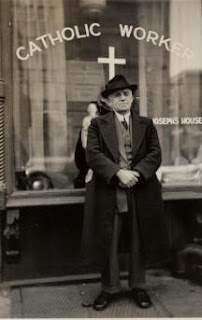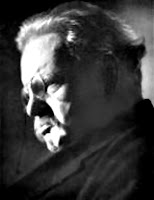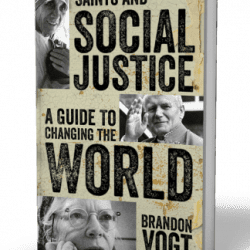(My husband showed me this book in a half-price bookstore a couple of years ago and after reading it my life has never been the same. This book introduced me to the Catholic Worker movement, which I barely knew beforehand. It now stands as the first of many books I have read about the movement and the cause for many long conversations between my husband and I about how we understand and try to live out our faith. Since reading the book, we have had the pleasure to meet the authors, Mark and Louise Zwick, founders of the Houston Catholic Worker [Casa Juan Diego] and who day after day, without a break, perform the corporal works of mercy that Day and Maurin emphasized so much.)
Dorothy Day and Peter Maurin Misunderstood
Known by many only as a secular activist or as a Communist by her strongest opponents, Dorothy Day was far from being either one. In fact, during their lifetime, Dorothy Day and Peter Maurin, the founders of the Catholic Worker Movement, fiercely opposed Communism, because its ideologies hurt the dignity of the human person and did not uphold the inalienable rights of all human beings that they strongly fought for. They did not like to be called conservatives or liberals, as they believed that the values that they stood up for were simply Catholic, and therefore, true. Dorothy Day and Peter Maurin, were and are still considered as radicals, which they did not mind, because to them Radicalism “meant getting down to the roots.”
Many know about her abortion or her participation in radical secular movements, but only few know about her devotion to the saints, daily Mass, and the Divine Office. Dorothy explains how she explained to communists her conversion to Catholicism:
“I had a conversation with John Spivak, the Communist writer, a few years ago and he said to me, ‘How can you believe? How can you believe in the Immaculate Conception, in the Virgin birth, in the Ressurection?’ I could only say that I believe in the Roman Catholic Church and all She teaches.I have accepted her authority with my whole heart.”
Mission Statement of the Catholic Worker Movement
The Catholic Worker Movement did not have a complex statement of purpose. In fact, their mission statement can be summarized by the passage of the “Separation of the Goats and the Sheep” in Matthew 25:31-46. Dorothy and Peter as well as all Catholic workers today remind everyone that what we don’t do for the most vulnerable, we don’t do for our Lord: “what you did not do for one of these least ones, you did not do for me.” (Mt 25:45). Hence, the works and deeds of the Catholic workers are centered on the Spiritual Works of Mercy and also the defense of life at all of its stages in order to demand a restoration of the social order with an ethic and economics that ensure the common good.
Monasticism in the Catholic Worker Movement
Dorothy and Peter were very familiar with the early Church Fathers, especially the Desert Fathers. Peter was especially familiar with the influence that monasticism had in Europe in restoring the social order during the Dark Ages. Hearing the call from Pius XI for a reconstruction of the social order at the time, Peter saw it necessary to return to the monastic way of life characterized by work, prayer, scholarship, and hospitality.
The Catholic worker houses were called Houses of Hospitality and the aim and purposes of these houses, according to Dorothy, were to
the aim and purposes of these houses, according to Dorothy, were to
“…form a center of Catholic action in all fields, to work for, teach and preach social justice, to form a powerhouse of genuine spirituality and earnest educational and vocational work, to dignify and transform manual labor, and to work for the glory and love of God and His Church.”
Due to the monastic roots of the Catholic Worker’s vision, it made the movement’s aim a “way that is so old it looks like new.” Similar to the monastery structure, Peter and Dorothy tried to implement schedules at the Houses of Hospitality, but due to the nature of their service to the poor, sometimes they were not strictly followed. Their usual schedule looked (and still looks) like this:
5-7 Work in the Fields
7-9 Mass
9-10 Breakfast
10-11 Lecture or Discussion
11-2 Rest or Study
2-3 Lecture or Discussion
3-4 Cold Lunch
4-5 Lesson in Handicraft
5-8 Work in the Field
8-9 Dinner
9-5 Sleep

Spiritual Roots: Imitation of saints, not just mere admiration
The book has a single chapter for each saint that influenced the movement. The Zwicks take you through Peter’s strong devotion and practical imitation of Saint Francis of Assisi and how he introduced this saint to the Movement’s principles. Other saints that strongly influenced Dorothy and Peter were St. Catherine of Siena, St. Thérèse of Lisieux, St. Teresa of Ávila, and St. John of the Cross. Many writings and talks by Dorothy and Peter are filled with direct quotes from all of these saints. The founders of the movement insisted that these saints should be imitated daily, instead of just admiring their work and devotion.
Intellectual Roots: Personalism, Distributism, and Pacifism
Not having ever been formally introduced to personalism or distributism, I have to say that these were the chapters of the book that I appreciated the most. The book takes you through the thought of those intellectuals involved in the personalist movement such as Nicholas Berdyaev, Emmanuel Mounier, Jacques Maritain, and Jean Daniélou. The ideas borrowed from these intellectuals were used in context with the social papal encyclicals written at the time by Popes Leo XIII and Pius XI in the development of the thought of the Catholic Worker Movement. The rights of workers to fair wages, the dignity of the human person and human life, subsidiarity, option for the poor, and private property are all contained in the principles of the movement that are at the same time the pillars of the social teaching of the Church.
I have to say that these were the chapters of the book that I appreciated the most. The book takes you through the thought of those intellectuals involved in the personalist movement such as Nicholas Berdyaev, Emmanuel Mounier, Jacques Maritain, and Jean Daniélou. The ideas borrowed from these intellectuals were used in context with the social papal encyclicals written at the time by Popes Leo XIII and Pius XI in the development of the thought of the Catholic Worker Movement. The rights of workers to fair wages, the dignity of the human person and human life, subsidiarity, option for the poor, and private property are all contained in the principles of the movement that are at the same time the pillars of the social teaching of the Church.
Dorothy Day’s personalism anticipated much of what would have been the thought of John Paul II’s papacy in the later part of the twentieth century. The late pope focused on three main  points of Catholic social teaching that were much in agreement with those of the Catholic Worker Movement: the dignity of the human person, solidarity, and subsidiarity.
points of Catholic social teaching that were much in agreement with those of the Catholic Worker Movement: the dignity of the human person, solidarity, and subsidiarity.
To further explain the Catholic Worker’s vision of an economy that is worthy of the human person, the common good and the evils of individualism, the book touches on the thought of distributists such as G. K. Chesterton, Hillaire Belloc, Fr. Vincent McNabb, OP., among others. All of these distributists present strong criticisms of capitalism that are worth reading. Strong crititicsm of “Calvinist” tendencies found in the works of George Weigel and Michael Novak are also present in the book. The Catholic Worker vision of economics is also complemented with the early Church Fathers and contemporary Catholic social teachings on the common good.
Dorothy and Peter’s Challenge
Reading this account of the thought and the work of Peter and Dorothy may leave you feeling disturbed and uncomfortable. At least this is what this book did for me. When we read the writings of famous saints and what they did, we feel inspired but too often we romanticize their lives. We can’t do this with Dorothy, Peter, or Mother Teresa, because they lived in our time. Dorothy and Peter are twentieth century saints that lived in the same society that we live today: with the same problems and the same challenges. Hence, the Catholic Worker Movement leaves all of us with a decision to make: to put our love of God into action. In Dorothy’s words:
“The love of brother, that care for his freedom is what causes us to go into such controversial subjects as man and the state, war and peace. The implications of the Gospel teaching of the Works of Mercy, lead us into conflict with the powers of this world.
Our love of God is a consuming fire. It is a living God and a living faith that we are trying to express. When we begin to take the lowest place, to wash the feet of others, to love our brothers with that burning love, that passion, which led to the Cross, then we can truly say, ‘Now I have begun.’”
Canonization for Dorothy Day
Dorothy Day was declared a Servant of God by John Paul II when the canonization process was opened for her as requested by the late Cardinal John O’Connor of New York. In his letter to the Congregation for the Causes of the Saints that opened the canonization process, the Cardinal describes Dorothy’s dramatic conversion as similar to St. Augustine’s given that Dorothy had committed grave sins before she met Christ, something which she regretted her entire life:
“It has long been my contention that Dorothy Day is a saint—not a ‘gingerbread’ saint or a ‘holy card’ saint, but a modern day devoted daughter of the Church…
To be sure, her life is a model for all in the third millennium, but especially for women who have had or are considering abortions.It is a well-known fact that Dorothy Day procured an abortion before her conversion to the Faith. She regretted it every day of her life. After her conversion from a life akin to that of the pre-converted Augustine of Hippo, she proved a stout defender of human life. The conversion of mind and heart that she exemplified speaks volumes to all women today on two fronts.First, it demonstrates the mercy of God, mercy in that a woman who sinned gravely could find such unity with God upon conversion. Second, it demonstrates that one may turn from the ultimate act of violence against innocent life in the womb to a position of total holiness and pacifism. In short, I contend that her abortion should not preclude her cause, but intensifies it.”













